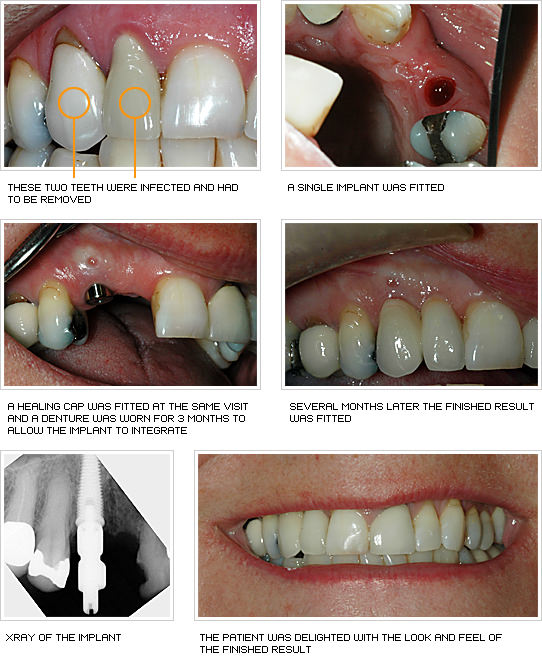What Does Dental Sense Do?
What Does Dental Sense Do?
Blog Article
Dental Sense Things To Know Before You Buy
Table of ContentsAn Unbiased View of Dental SenseHow Dental Sense can Save You Time, Stress, and Money.All About Dental SenseA Biased View of Dental Sense
are clinical tools operatively implanted into the jaw to recover an individual's ability to chew or their appearance. They supply support for fabricated (phony) teeth, such as crowns, bridges, or dentures. When a tooth is shed due to injury or illness, an individual can experience complications such as quick bone loss, faulty speech, or changes to eating patterns that result in pain.Dental dental implant systems contain a dental implant body and oral implant joint and may likewise consist of an abutment fixation screw. Kids dental. The dental implant body is operatively put in the jawbone in area of the tooth's root. The oral implant abutment is usually connected to the dental implant body by the abutment addiction screw and expands via gums into the mouth to support the affixed man-made teeth
(https://disqus.com/by/dentalsense1/about/)Structure of The Dental Implant System selecting dental implants, speak with your oral provider about the prospective advantages and risks, and whether you are a prospect for the treatment. Points to consider: Your general health and wellness is an important aspect in determining whether you are a great candidate for oral implants, how long it will certainly require to heal, and for how long the implant might remain in area.
Cigarette smoking may impact the healing process and decrease the lasting success of the implant. The recovery procedure for the dental implant body might take numerous months or longer, during which time you typically have a short-lived joint in place of the tooth. the dental implant procedure: Carefully follow the oral hygiene instructions provided to you by your oral service provider.
Dental Sense for Beginners
Implant failing can lead to the need for another procedure to fix or change the implant system. Restores the capability to chew Brings back cosmetic look Aids keep the jawbone from shrinking because of bone loss Preserves the wellness of the bordering bone and periodontals Aids maintain surrounding (nearby) teeth stable Enhances top quality of life Damages to bordering natural teeth during implant positioning Injury to the surrounding tissues throughout surgery, such as sinus opening Injury throughout surgical procedure (as an example, fracture of bordering jawbone) Insufficient function, such as seeming like the teeth do not bite with each other usually An experience that the tooth is loose or twisting in position resulting from an abutment screw loosening Implant body failing (looseness of the dental implant body) as a result of systemic infection, which might be more probable in people with uncontrolled diabetes mellitus due to local infection in bone and gums supporting the implant body because of postponed recovery, which may be extra likely in patients that smoke Problem cleansing the gums around the implant, causing inadequate dental hygiene Untreated gum illness Post-surgical pins and needles due to nerve impingement or damages Always inform health and wellness treatment suppliers and imaging technicians that you have dental implants prior to any type of magnetic resonance imaging (MRI) or x-ray treatments.
FDA is not knowledgeable about any kind of damaging events reported for MRI Full Report or x-ray procedures with dental implants. Oral implants systems are generally made of materials that comply with worldwide agreement requirements of the International Company for Standardization (ISO) or ASTM International. These criteria have details of what makes a secure material.

An oral implant is a framework that changes a missing tooth. With screw-like devices, the cosmetic surgeon inserts an implant right into the jawbone, and it functions as an anchor for a fabricated tooth, called a crown. A gadget called a joint connects the man-made tooth to the dental implant. The crown is customized to fit the individual's mouth and match the shade of their teeth.
The Ultimate Guide To Dental Sense
Some individuals are not eligible for oral implant surgical procedure. It is for dental doctors to operate individuals with: severe illnessuncontrollable metabolic diseasebone or soft tissue illness or infectionIf these problems are solved, a person can have the surgical procedure. In, dental cosmetic surgeons avoid operating on individuals with: If individuals with any of the above go through dental implant surgical procedure, there is a greater threat of the dental implant failing.

Oral dental implant surgical procedure is a personalized procedure. It's not the very same for every person. However the following provides a basic introduction of what you can anticipate your dentist, dental surgeon, periodontist or prosthodontist to do: Place the implant surgically. Provide you time to heal. Connect the message and final crown, bridge or denture.
Next off, your cosmetic surgeon will carefully put the oral implant into your jaw. Lastly, your specialist will certainly reposition your periodontals and shut the incision with stitches. If your dental implant is near the front of your mouth, your dentist will make a short-lived tooth for you to use up until you recover. That method, you will not have a void in your smile while you recoup.
What Does Dental Sense Mean?
Your copyright can inform you what to anticipate in your circumstance. During the recovery phase, your jawbone should fuse to the dental implant. This process, called osseointegration, is important for stability and lasting success. This procedure can take anywhere from 3 to 9 months. In some situations, it might take longer.
When your implant heals, your dental practitioner can connect the abutment (tiny adapter post) and your final reconstruction (crown, bridge or denture). This typically takes concerning one hour to complete and might require a second small surgery. You should not feel any pain during your oral implant procedure due to the fact that your service provider will make use of medicine to numb your gums.
Report this page